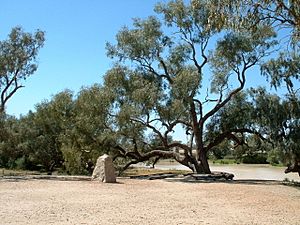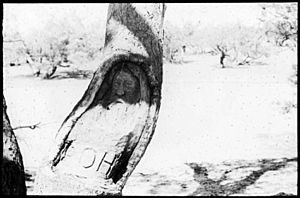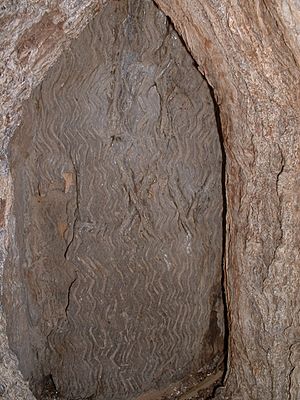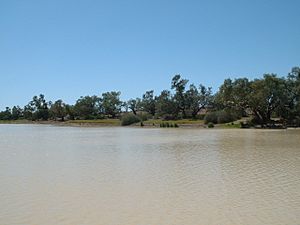Burke and Wills Dig Tree facts for kids
Quick facts for kids Burke and Wills Dig Tree |
|
|---|---|

Burke and Wills Dig Tree, 2008
|
|
| Location | Nappa Merrie Station, Durham, Shire of Bulloo, Queensland, Australia |
| Design period | 1840s - 1860s (mid-19th century) |
| Built | 1861 April 21 - 1861 April 21 |
| Official name: Burke and Wills Dig Tree | |
| Type | state heritage (landscape) |
| Designated | 28 February 2003 |
| Reference no. | 601073 |
| Significant period | 1861 (historical) |
| Significant components | plaque, cairn, signage - interpretative |
| Lua error in Module:Location_map at line 420: attempt to index field 'wikibase' (a nil value). | |
The Burke and Wills Dig Tree is a famous eucalyptus tree in Queensland, Australia. It's known for its connection to the Burke and Wills expedition, a major journey of exploration in Australia. On 21 April 1861, a message was carved into this tree. It pointed to a hidden supply of food and equipment. Today, the tree is a protected heritage site.
Contents
The Story of the Dig Tree
The Burke and Wills Dig Tree stands on the banks of Cooper Creek. It is linked to the explorers Robert O'Hara Burke and William John Wills. This tree was one of two trees marked on 21 April 1861. This was done by William Brahe and his team. They had stayed at Cooper's Creek while Burke, Wills, Charles Gray, and John King pushed on towards Australia's northern coast.
The Victorian Exploring Expedition
Robert O'Hara Burke was born in Ireland in 1821. He served in the military before moving to Australia in 1853. He became a police officer in Victoria. Burke was chosen to lead the Victorian Exploring Expedition. He really wanted this important job.
William John Wills was born in England in 1834. He studied medicine and came to Australia in 1853. Wills later learned about surveying and astronomy. He joined the expedition as the astronomer, surveyor, and second-in-command.
The expedition aimed to be the first to cross Australia from south to north. It was a very big and expensive project. The explorers left Melbourne on 20 August 1860. Their party included fifteen men, twenty-six camels, horses, wagons, and lots of supplies.
Burke wanted to travel quickly. He left some equipment and food behind at different stops. He also had disagreements with some of his team members. Burke promoted Wills to second-in-charge. He also hired William Wright as a third officer.
Burke was told to set up his main base camp at Cooper's Creek. But he decided to push ahead quickly with a smaller group of eight. He left the rest of the men and supplies with Wright. Wright was supposed to bring the supplies to Cooper's Creek as soon as possible. However, Wright waited for three months. This delay meant vital supplies did not arrive before Burke returned.
The Coopers Creek Depot
On 6 December 1860, Burke and his seven men set up Camp LXV (Camp 65) at Cooper's Creek. They had spent weeks looking for the best spot for a long-term depot.
Burke then decided to split his group again. On 16 December, he continued towards the Gulf of Carpentaria. Only Wills, King, and Gray went with him. William Brahe, Thomas McDonough, William Patten, and Dost Mahomet were told to wait at Camp LXV for at least three months. They were then to return home. Brahe's group built a wooden stockade to protect themselves and their supplies. This also kept local Aboriginal people away from their camp.
Four months later, on the morning of 21 April 1861, Brahe and his three companions left Camp LXV. They were heading back to Menindee. Before leaving, Brahe carved three messages on two different Coolibah trees at the camp. One carving included the word 'DIG'. It showed where a hidden supply of food and equipment was buried.
Two other marks were carved on a tree nearby. One had the letter 'B' for Burke and the camp number 'LXV'. The other showed the dates their party arrived (6 December 1860) and when Brahe left (21 April 1861). Brahe wrote in his journal that they left 50 pounds of flour, 50 pounds of oatmeal, 50 pounds of sugar, and 30 pounds of rice buried. He marked the word "Dig" on the tree.
Brahe took all the camels, horses, and most of the remaining food. He later said he didn't really expect Burke to return. He left the message for any other explorers who might come by.
Burke's party, now only three men after Gray died on 17 April 1861, reached Camp LXV on the evening of 21 April 1861. They had only two tired camels left and very little food. They found that Brahe had left that very day. They saw the messages carved into the Dig Tree, pointing to the buried supplies. What happened next was a series of missed chances and communication failures.
A week after leaving Camp LXV, Brahe met Wright's party. Wright was finally on his way north to Cooper's Creek. Brahe and Wright then returned to the camp. But they saw no sign that Burke had returned on 21 April. So, they left no new messages and went back south. Brahe arrived in Melbourne in June 1861 to report the men missing.
On April 23, Burke's group started a 150-mile journey west. They hoped to reach Blanchewater Station in South Australia. They chose this direction over the longer, but known, path to Menindee. Twice they had to turn back to Cooper's Creek because there was no water to the west. They stayed along the Creek throughout June.
On 30 May 1861, Wills returned to Camp LXV. He found no sign that Brahe had returned in early May. Wills placed his journals and a new note in the buried supplies. He did this to protect them. He then went back to his companions along Cooper's Creek.
The men survived by eating ground nardoo. But they didn't know how to prepare it properly to remove its toxins. This made them very sick. Wills died alone on the banks of Cooper's Creek on 27 or 28 June. He had told his friends to go further up the creek to find help from the Aboriginal people. A day or two later, Burke also died. He had sent King to look for help. With the help of Aboriginal people, King survived. He was found on 15 September 1861 by Alfred William Howitt's search party.
Rescue Efforts
When news spread that the expedition had failed, many search parties were quickly formed. Howitt left from Melbourne. John McKinlay came from Adelaide. Frederick Walker came from Rockhampton. And William Landsborough came from Brisbane.
Howitt's party, which included Brahe, arrived at Camp LXV on 13 September 1861. They found the depot just as Brahe had left it. They found Wills' body where King had covered it, some miles downstream. They buried Wills on 18 September 1861 and marked a tree. They also found Wills' field books and other small items.
Three days later, Howitt found Burke's body about seven miles away. This was near Innamincka Waterhole in South Australia. Burke was buried wrapped in a Union Jack flag, under a box tree. Howitt marked this tree at the head of Burke's grave.
The search parties helped open up large parts of inland Australia for settlement. They brought back much new knowledge about the land. By the time Burke and Wills had a public funeral in January 1863, farmers were already bringing sheep and cattle into the area. Within about ten years, there were homesteads along Cooper's Creek. This included Nappa Merrie sheep station, started in 1873.
The Dig Tree's Importance
The Dig Tree was not immediately famous because it wasn't directly where Burke or Wills died. But by the 1880s, trees marked by explorers became very important. People saw them as historical treasures. The Dig Tree eventually became central to the expedition's story. This was partly due to John Longstaff's famous 1907 painting, The Arrival of Burke, Wills and King at the deserted Camp at Coopers Creek.
The Dig Tree has been seen as historically important to Queensland for most of the 20th century. In 1937, the Conrick Plaque was placed on a stone pile near the Dig Tree. On 2 July 1964, the Queensland Government made the area around the Dig Tree a reserve for memorial purposes. The Stanbroke Pastoral Company now manages the site.
In 1993, the Department of Environment & Heritage added signs to explain the site. More signs were put up around 1997. Later, boardwalks were built around the Dig Tree and the Face Tree. This helps protect the ground from visitors' footsteps. Toilets were also built in 2001. The Face Tree is on the same reserve. It shows a carving of Robert O'Hara Burke's face and the letters ROHB. People believe John Dick carved it in 1898.
What the Dig Tree Looks Like
The Dig Tree is about four to six kilometres southwest of Nappa Merrie homestead. It is on a special Reserve for Memorial Purposes. This reserve is about 4,470 square metres. It is part of the large Nappa Merrie cattle station. The homestead is close to the South Australian border. It is about 380 kilometres west of Thargomindah.
The Dig Tree is a mature Coolibah tree (Eucalyptus microtheca). It is thought to be 200 to 250 years old. These trees are common along Cooper Creek. They grow in dry areas near water or in places that flood sometimes. The tree stands high above the creek, on the southern bank of the Bulloo Bulloo waterhole.
Brahe carved two marks into this tree in 1861. On the side facing the creek, "B/LXV" means Brahe and Camp 65 in Roman numerals. On a branch facing upstream, "DEC 6.60 APR 21.61" marks the date the camp was set up and the date Brahe left. The bark has grown over the 'date blaze', so it's hard to see now. On a nearby tree, Brahe carved the message "DIG THREE FT NW." This told people to dig three feet northwest for supplies.
When Alfred Howitt returned to Cooper Creek in 1862, he collected the bodies of Wills and Burke. A member of his team, Alexander Aitken, carved another "DIG" message. This was on the other side of the same tree where Brahe had carved "B/LXV." This new message read: "AH" (Howitt's initials) "DIG UNDER ----> TO DEPOT". This "Dig" message pointed to information buried in a bottle. It was about Howitt's supply depot further south.
A wooden boardwalk has been built around the tree. This stops visitors from walking directly on the ground. It helps protect the tree's roots. A stone cairn (a pile of stones) is about 40 feet northwest of the Dig Tree. Further northwest is the Conrick Plaque, a metal sign on a large stone. Newer signs near the Dig Tree tell the story of Burke and Wills.
The Face Tree (Eucalyptus microtheca) is also on the banks of the waterhole. It is downstream (southwest) from the Dig Tree. It shows a carving of Robert O'Hara Burke's face and the letters ROHB.
Why the Dig Tree is Important
The Burke and Wills Dig Tree was added to the Queensland Heritage Register on 28 February 2003. It is important for several reasons:
- It shows how Queensland's history developed.
The Dig Tree is important because the Burke and Wills expedition helped open up the Australian inland for farming. In the 1860s, settlers started bringing sheep and cattle into the Channel Country. They grazed their animals along Cooper's Creek. Just twelve years after Burke and Wills died, the land around the Dig Tree became part of Nappa Merrie station.
- It is linked to important people in Queensland's history.
The Burke and Wills Dig Tree and Camp 65 are important because of their connection to explorers Robert O'Hara Burke and William John Wills. They were the first to cross the Australian continent from north to south. Both died on their return journey in 1861. Their journey was amazing for its toughness and also for its mistakes. It has become a famous part of Australian history. The Dig Tree is a special landmark for many Australians. Many visitors come to see it every year.




